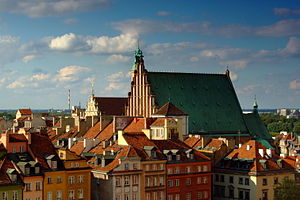St. John's Archcathedral, Warsaw
| St. John's Archcathedral in Warsaw Archikatedra św. Jana w Warszawie |
|
|---|---|
 |
|
| Location | Warsaw |
| Country | Poland |
| Denomination | Roman Catholic |
| History | |
| Founded | 1390 |
| Architecture | |
| Style | Brick Gothic |
St. John's Archcathedral in Warsaw (Polish: Archikatedra św. Jana w Warszawie) is a Catholic church in Warsaw's Old Town. St. John's is one of three cathedrals in Warsaw, but the only one which is also an archcathedral. It is the mother church of the archdiocese of Warsaw. St. John's Archcathedral is one of Poland's national pantheons and stands immediately adjacent to Warsaw's Jesuit church. Along with the city, the church has been listed by UNESCO as of cultural significance.
Originally built in the 14th century in Masovian Gothic style, the Cathedral served as a coronation and burial site for numerous Dukes of Masovia.
The Archcathedral was connected with the Royal Castle (Zamek Królewski w Warszawie) by an elevated 80-meter-long corridor that had been built by Queen Anna Jagiellonka in the late 16th century and extended in the 1620s after Michał Piekarski's failed 1620 attempt to assassinate King of Poland Sigismund III in front of the Cathedral.
After the resolution of the Constitution of May 3, 1791, at the end of the session at the Royal Castle, King Stanisław August Poniatowski went to the Cathedral of St. John to repeat the Oath of the Constitution in front of the Altar, in the face of God. Also the Marshals of the Great Sejm were carried to the Archcathedral on the shoulders of the enthusiastic deputies of the Sejm.
The church was rebuilt several times, most notably in the 19th century, it was preserved until World War II as an example of English Gothic Revival.
...
Wikipedia
